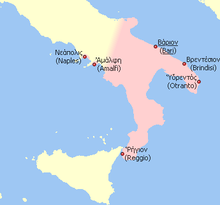Catepanate of Italy
| Catepanate of Italy Κατεπανίκιον Ἰταλίας | |||||||||||
|---|---|---|---|---|---|---|---|---|---|---|---|
Province of the Byzantine Empire | |||||||||||
| 965–1071 | |||||||||||
 Approximate territorial extent of the Catapanate of Italy during the early 11th century. Modern city names (in Italian, except from Napoli) are provided alongside the medieval Greek names. | |||||||||||
| Capital | Bari | ||||||||||
| Historical era | Middle Ages | ||||||||||
• Established | 965 | ||||||||||
| 1071 | |||||||||||
| |||||||||||
| Today part of | Italy | ||||||||||
The Catepanate (or Catapanate) of Italy (
Capitanata derives its name from katepanikion
.
History
Following the fall of the
patrikios. The title of katepanō meant "the uppermost" in Greek. This elevation was deemed militarily necessary after the final loss of nearby Sicily
, a previously Byzantine possession, to the Arabs.
Some
Ranulf Drengot in the fortress of Aversa in 1030. This gave the Normans their first foothold in southern Italy from which they began an organized conquest of the land. In 1030, William and Drogo, the two eldest sons of Tancred of Hauteville, a noble of Coutances in Normandy arrived in southern Italy. The two joined in the organized attempt to wrest Apulia from the Byzantines, who had lost most of that province by 1040. Bari was captured by the Normans in April 1071, and Byzantine authority was finally terminated in Italy, five centuries after the conquests of Justinian I. In 1154-1156, through a plan hatched by Emperor Manuel I Komnenos, the Byzantines returned briefly to besiege Bari and were moderately successful in inciting a mass revolt which nearly toppled Norman control (potentially handing much of the former Katepanate back to the Byzantine Empire), but the gains were "reversed by misfortune".[5][6]
The title Catapan of Apulia and Campania was revived briefly in 1166 for Gilbert, Count of Gravina, the cousin of the queen regent Margaret of Navarre. In 1167, with his authority as catapan, Gilbert forced German troops out of the Campania and compelled Frederick Barbarossa to raise the siege of Ancona.
Catepans
- 970–975 Michael Abidelas
- before 982 Romanos
- 982–985 Kalokyros Delphinas
- 985–988 Romanos
- 988–998 John Ammiropoulos
- 999–1006 Gregory Tarchaneiotes
- 1006–1008 Alexios Xiphias
- 1008–1010 John Kourkouas
- 1010–1016 Basil Mesardonites
- May 1017 – December 1017 Leo Tornikios Kontoleon
- December 1017 – 1027 Basil Boioannes
- c. 1027–1029 Christophoros Burgaris
- July 1029 – June 1032 Pothos Argyros
- 1032 – May 1033 Michael Protospatharios
- May 1033 – 1038 Constantine Opos
- 1038–1039 Michael Spondyles
- February 1039 – January 1040 Nikephoros Dokeianos
- November 1040 – Summer of 1041 Michael Dokeianos
- Summer 1041 – 1042 Exaugustus Boioannes
- February 1042 – April 1042 Synodianos
- April 1042 – September 1042 George Maniakes
- Autumn 1042 Pardos
- February 1043 – April 1043 Basil Theodorokanos
- Autumn 1045 – September 1046 Eustathios Palatinos
- September 1046 – December 1046 John Raphael
- 1050–1058 Argyrus
- 1060/1061 Marules
- 1062 Sirianus
- 1064–1068 Abulchares
- 1068 Perenos
- 1071 Stephen Pateranos
References
- ^ Kreutz 1996, pp. 41–43.
- ^ Kreutz 1996, p. 57.
- ^ Kreutz 1996, p. 63.
- ^ Kreutz 1996, pp. 63–66, 68.
- ^ Kinnamos. The Deeds of John and Manuel Komnenos.
- ^ Choniates. Historia.
Sources
- Charanis, Peter. "On the Question of the Hellenization of Sicily and Southern Italy During the Middle Ages." The American Historical Review. Vol. 52, No. 1 (Oct., 1946), pp. 74–86.
- Kreutz, Barbara M. (1996). Before the Normans: Southern Italy in the Ninth and Tenth Centuries. Philadelphia: University of Pennsylvania Press. ISBN 0-8122-1587-7.
- Loud, G.A. (2006). "Southern Italy in the tenth century". In Reuter, Timothy (ed.). The New Cambridge Medieval History, Volume III c. 900–c. 1204. Cambridge University Press. pp. 624–645. ISBN 978-0-521-36447-8.
- Loud, Graham (2013). The Age of Robert Guiscard: Southern Italy and the Northern Conquest. New York: Routledge. ISBN 978-0-582-04529-3.
- White, Lynn, Jr.. "The Byzantinization of Sicily." The American Historical Review. Vol. 42, No. 1 (Oct., 1936), pp. 1–21.
